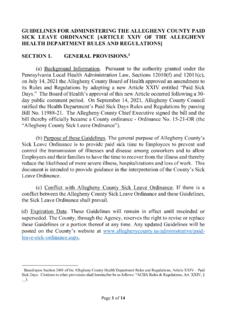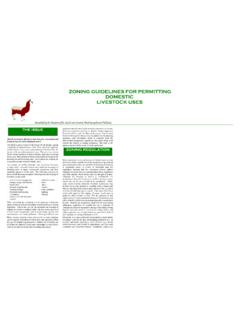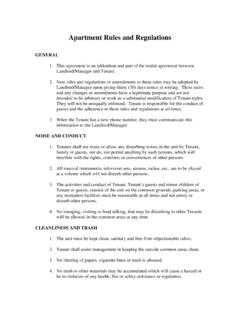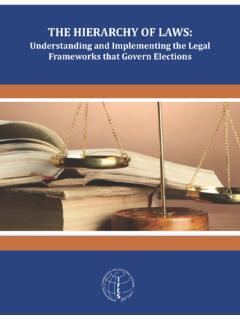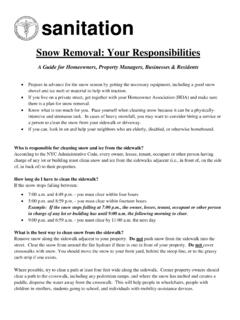Transcription of CROSS CONNECTION RULES MANUAL - Michigan
1 CCrroossss CCoonnnneeccttiioonn RRuulleess MMaannuuaall Fourth Edition October 2008 Michigan Department of Environmental Quality Resource Management Division Rick Snyder, Governor Dan Wyant, Director Michigan DEPARTMENT OF ENVIRONMENTAL QUALITY RESOURCE MANAGEMENT DIVISION 525 WEST ALLEGAN STREET BOX 30241 LANSING, Michigan 48909-7741 517-335-2690 The Michigan Department of Environmental Quality (DEQ) will not discriminate against any individual or group on the basis of race, sex, religion, age, national origin, color, martial status, disability, or political beliefs.
2 Questions or concerns should be directed to the DEQ Office of Personnel Services, Box 30473, Lansing, MI 48909 CROSS CONNECTION RULES MANUAL FOURTH EDITION October 2008 Michigan Department of Environmental Quality Resource Management Division 525 West Allegan Street Post Office Box 30241 Lansing, Michigan 48909-7741 ACKNOWLEDGEMENTS The department wishes to thank the United States Environmental Protection Agency for permission to use some of the illustrations from their CROSS CONNECTION Control MANUAL . The department would also like to thank the following individuals for their assistance and expertise in the rewriting of this MANUAL .
3 Matt Kapcia City of Troy Mike Lueck Mid-West Instrument Mike Smith Grand Traverse County Barry Walter HydroDesigns, Inc. (i) FOREWORD 4th EDITION In the water supply field, a considerable amount of attention is being focused nationally on new drinking water standards, source water protection and enhanced treatment. However, water supply professionals must remain vigilant in their efforts to protect the integrity of the potable water after it enters the distribution system. The continued expansion of public water distribution systems in Michigan has resulted in thousands of additional service connections annually.
4 Therefore, CROSS CONNECTION control remains a critical link in protecting public health by maintaining the quality of drinking water from the source, through the distribution system and to the customers. Drinking water quality will be jeopardized without a persistent effort in CROSS CONNECTION control, regardless of efforts to protect the source of supply and improved treatment techniques. This MANUAL strives to educate water system operators, plumbers, contractors and any others in the industry about the need for effective CROSS CONNECTION control. Acronym Key Act 399 Michigan Safe Drinking Water Act, 1976 PA 399, as Amended, and the Administrative RULES ASSE American Society of Sanitary Engineering AVB Atmospheric Vacuum Breaker CSA Canadian Standards Association DCVA Double Check Valve Assembly DEQ Department of Environmental Quality DLEG Department of Labor and Economic Growth HBVB Hose Bib Vacuum Breaker MPC Michigan Plumbing Code PVB Pressure Vacuum Breaker RPZ Reduced Pressure Principle Backflow Assembly (ii)
5 WATER SUPPLY CROSS CONNECTION RULES MANUAL (Incorporated by the Water Bureau as a Supplement to Part 14 of the Administrative RULES under the Michigan Safe Drinking Water Act) TABLE OF CONTENTS Page Number Chapter 1 1 Chapter 2 Water Supply CROSS CONNECTION 3 Chapter 3 CROSS CONNECTION 6 Chapter 4 Backflow Prevention 11 Chapter 5 26 Chapter 6 Common 29 Chapter 7 Common Facilities To 40 Chapter 8 .. 43 Chapter 9 Local CROSS CONNECTION Control 44 Chapter 10 Containment, Isolation and Piping 46 Chapter 11 Acceptable Means of 47 Chapter 12 Customers To 48 Chapter 13 49 Appendix A - Suggested Model Ordinance Appendix B - CROSS CONNECTION Control Program (CCCP) Guidance Outline Appendix C - Model CROSS CONNECTION Control Programs Appendix D - Sample Record Keeping Forms Appendix E - Backflow Assembly Test Procedures Appendix F - Sample Letters Appendix G - Approved Backflow Preventers (iii)
6 1 Chapter 1 - INTRODUCTION A CROSS CONNECTION is a CONNECTION or arrangement of piping or appurtenances through which backflow of nonpotable water could flow into the public drinking water supply. Historically, the waterworks industry has made a determined effort to provide the consumer with an unlimited quantity of high quality water. Much of this effort has been concentrated on the production of quality treated water with insufficient attention paid to protecting the quality of the water within the distribution system. Inappropriate connections between piping containing contaminants or potential contaminants and potable water supply piping are encountered on all public water supply distribution systems.
7 The control of these CROSS connections is difficult since it demands the inspection and necessary reinspection of industrial and commercial establishments, as well as some control of public and private dwellings, including homes. Too often total reliance has been placed on producing safe water and attempting to maintain adequate pressure at all times throughout the distribution system. While these efforts are of extreme importance, they have not proved to be entirely effective in protecting water quality within the distribution system. It is essential that all CROSS connections on the public water supply distribution system be removed in order to protect water quality when system pressures are less than adequate to prevent backflow.
8 The water supply CROSS CONNECTION RULES define CROSS CONNECTION as, "a CONNECTION or arrangement of piping or appurtenances through which a backflow could occur." In turn, backflow means, "water of questionable quality, wastes or other contaminants entering a public water supply system due to a reversal of flow." By definition then, the term backflow includes situations caused by either backpressure or backsiphonage. Since passage of the CROSS CONNECTION control RULES in April of 1972, much effort has been spent by many Michigan water utilities to maintain an effective CROSS CONNECTION control program.
9 Unfortunately, despite the best efforts of these water utilities, there continues to be documented cases in Michigan (as well as the United States) where nonpotable water or contaminants have entered the potable piping system via a CROSS CONNECTION . In Michigan , there have been past cases where ammonia refrigerant, malathion, propylene glycol, soap from a car wash and even brucellosis culture have backflowed into public distribution systems through unprotected CROSS connections. Therefore, water system personnel must continue to eliminate and prevent any CROSS connections with the public water supply system.
10 It is estimated that 90% of the incidents of backflow through CROSS connections are either unreported or unnoticed. Historically, an effort has been made to protect public water supplies from backflow by maintaining adequate pressure on the distribution system. The distribution system and onsite piping must be adequately sized to provide fire flows without serious loss of pressure if we are to be successful in protecting against backflow even with an ongoing CROSS CONNECTION control program. The design of the distribution system, including factors such as main placement and sizing, valving, and storage, is of extreme importance in protecting against backflow conditions.











